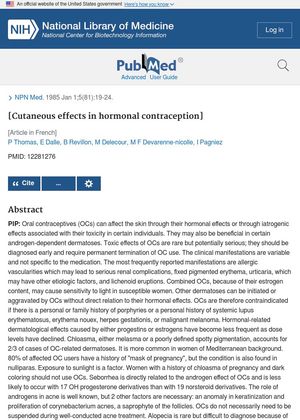Cutaneous Effects in Hormonal Contraception
January 1985
in “
PubMed
”

TLDR Hormonal birth control can cause skin issues, but low-dose options and those with antiandrogens may reduce these effects.
The 1985 study "[Cutaneous effects in hormonal contraception]" by P Thomas et al. discussed the effects of oral contraceptives (OCs) on the skin. The study found that OCs could affect the skin through hormonal effects or through iatrogenic effects associated with their toxicity in certain individuals. Toxic effects were rare but potentially serious, requiring early diagnosis and permanent termination of OC use. The most frequently reported manifestations were allergic vascularities, fixed pigmented erythema, urticaria, and lichenoid eruptions. OCs could also initiate or aggravate other dermatoses. Hormonal-related dermatological effects caused by either progestins or estrogens had become less frequent as dose levels declined. Chloasma accounted for 2/3 of cases of OC-related dermatoses. Seborrhea was directly related to the androgen effect of OCs. Alopecia was rare but difficult to diagnose. The study concluded that various dermatological risk factors should be ruled out before prescription of an OC. The development of pills containing the antiandrogen cyproterone acetate instead of a progestin in combination with ethinyl estradiol reduced androgenic effects in women and could be useful in cases of severe acne, severe seborrhea, androgenic alopecia, or excessive facial hair.



